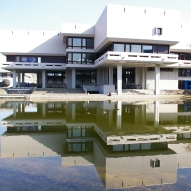Zusammenfassung
The ability of silica to influence the mineralization of alk.-earth carbonates is an outstanding example for the formation of biomimetic structures in the absence of any org. matter. Under suitable conditions, silica-stabilized carbonate nanocrystals can spontaneously self-assemble into hierarchical materials with complex morphologies, commonly referred to as "silica biomorphs". However, growth ...
Zusammenfassung
The ability of silica to influence the mineralization of alk.-earth carbonates is an outstanding example for the formation of biomimetic structures in the absence of any org. matter. Under suitable conditions, silica-stabilized carbonate nanocrystals can spontaneously self-assemble into hierarchical materials with complex morphologies, commonly referred to as "silica biomorphs". However, growth of these crystal aggregates has largely been restricted to the higher homologues in the alk.-earth series, i.e., SrCO3 and BaCO3, while corresponding architectures of the much more relevant calcium carbonate are quite difficult to realize. To systematically address this problem, we have crystd. metal carbonates in the presence of silica at high pH, using barium and strontium chloride solns. that contained increasing molar fractions of Ca2+. The resulting materials were analyzed with respect to their compn., structure, and crystallog. The obtained data demonstrate that the growth process is already strongly affected by small amts. of calcium. Indeed, morphologies typically obsd. for SrCO3 and BaCO3 remained absent above certain thresholds of added Ca2+. Instead, globular and hemispherical structures were generated, owing to fractal branching of carbonate crystals as a consequence of poisoning by silica. These alterations in the growth behavior are ascribed to relatively strong interactions of hard calcium ions with silicate species in soln., shifting their speciation toward higher oligomers and even inducing partial coagulation. This notion is confirmed by addnl. expts. at increased ionic strength. Our results further demonstrate that the obsd. hemispherical particles exhibit distinct polymorphism, with orthorhombic solid solns. (aragonite-type (Sr,Ca)CO3 and (Ba,Ca)CO3) being formed at lower Ca2+ contents, whereas Sr2+/Ba2+-substituted calcite prevails at higher Ca2+ fractions. In the case of Ba2+/Ca2+ mixts., there is moreover an intermediate range where virtually identical morphologies were confirmed to be Ba2+-doped vaterite. These findings extend the variety of structures and compns. accessible in these simple systems, and may explain difficulties previously encountered in attempts to prep. CaCO3 biomorphs at std. conditions.




 Altmetric
Altmetric